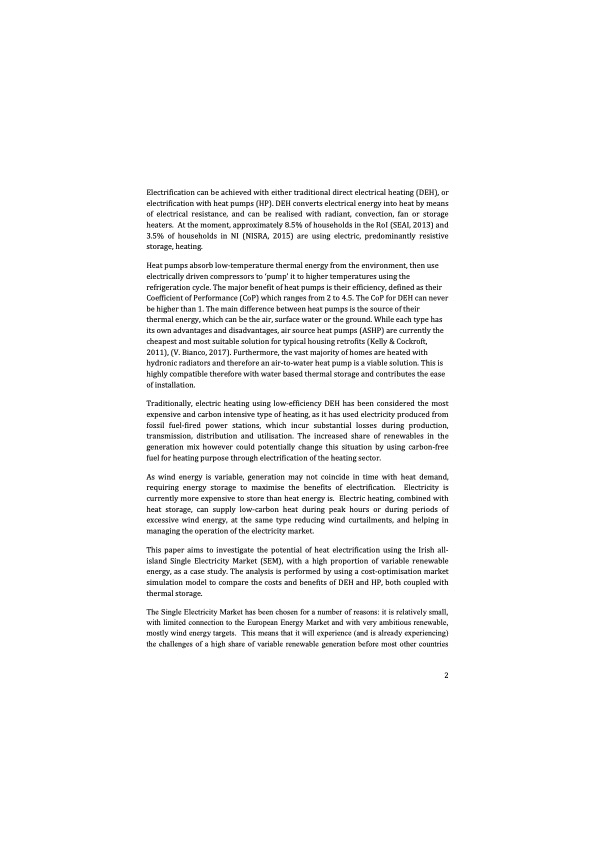
PDF Publication Title:
Text from PDF Page: 002
Electrification can be achieved with either traditional direct electrical heating (DEH), or electrification with heat pumps (HP). DEH converts electrical energy into heat by means of electrical resistance, and can be realised with radiant, convection, fan or storage heaters. At the moment, approximately 8.5% of households in the RoI (SEAI, 2013) and 3.5% of households in NI (NISRA, 2015) are using electric, predominantly resistive storage, heating. Heat pumps absorb low-temperature thermal energy from the environment, then use electrically driven compressors to ‘pump’ it to higher temperatures using the refrigeration cycle. The major benefit of heat pumps is their efficiency, defined as their Coefficient of Performance (CoP) which ranges from 2 to 4.5. The CoP for DEH can never be higher than 1. The main difference between heat pumps is the source of their thermal energy, which can be the air, surface water or the ground. While each type has its own advantages and disadvantages, air source heat pumps (ASHP) are currently the cheapest and most suitable solution for typical housing retrofits (Kelly & Cockroft, 2011), (V. Bianco, 2017). Furthermore, the vast majority of homes are heated with hydronic radiators and therefore an air-to-water heat pump is a viable solution. This is highly compatible therefore with water based thermal storage and contributes the ease of installation. Traditionally, electric heating using low-efficiency DEH has been considered the most expensive and carbon intensive type of heating, as it has used electricity produced from fossil fuel-fired power stations, which incur substantial losses during production, transmission, distribution and utilisation. The increased share of renewables in the generation mix however could potentially change this situation by using carbon-free fuel for heating purpose through electrification of the heating sector. As wind energy is variable, generation may not coincide in time with heat demand, requiring energy storage to maximise the benefits of electrification. Electricity is currently more expensive to store than heat energy is. Electric heating, combined with heat storage, can supply low-carbon heat during peak hours or during periods of excessive wind energy, at the same type reducing wind curtailments, and helping in managing the operation of the electricity market. This paper aims to investigate the potential of heat electrification using the Irish all- island Single Electricity Market (SEM), with a high proportion of variable renewable energy, as a case study. The analysis is performed by using a cost-optimisation market simulation model to compare the costs and benefits of DEH and HP, both coupled with thermal storage. 2 The Single Electricity Market has been chosen for a number of reasons: it is relatively small, with limited connection to the European Energy Market and with very ambitious renewable, mostly wind energy targets. This means that it will experience (and is already experiencing) the challenges of a high share of variable renewable generation before most other countriesPDF Image | How heat pumps and thermal energy storage with wind power

PDF Search Title:
How heat pumps and thermal energy storage with wind powerOriginal File Name Searched:
heat-pumps-thermal-energy.pdfDIY PDF Search: Google It | Yahoo | Bing
Turbine and System Plans CAD CAM: Special for this month, any plans are $10,000 for complete Cad/Cam blueprints. License is for one build. Try before you buy a production license. More Info
Waste Heat Power Technology: Organic Rankine Cycle uses waste heat to make electricity, shaft horsepower and cooling. More Info
All Turbine and System Products: Infinity Turbine ORD systems, turbine generator sets, build plans and more to use your waste heat from 30C to 100C. More Info
CO2 Phase Change Demonstrator: CO2 goes supercritical at 30 C. This is a experimental platform which you can use to demonstrate phase change with low heat. Includes integration area for small CO2 turbine, static generator, and more. This can also be used for a GTL Gas to Liquids experimental platform. More Info
Introducing the Infinity Turbine Products Infinity Turbine develops and builds systems for making power from waste heat. It also is working on innovative strategies for storing, making, and deploying energy. More Info
Need Strategy? Use our Consulting and analyst services Infinity Turbine LLC is pleased to announce its consulting and analyst services. We have worked in the renewable energy industry as a researcher, developing sales and markets, along with may inventions and innovations. More Info
Made in USA with Global Energy Millennial Web Engine These pages were made with the Global Energy Web PDF Engine using Filemaker (Claris) software.
Sand Battery Sand and Paraffin for TES Thermo Energy Storage More Info
| CONTACT TEL: 608-238-6001 Email: greg@infinityturbine.com | RSS | AMP |